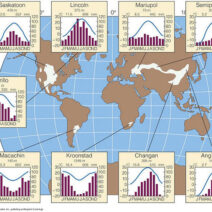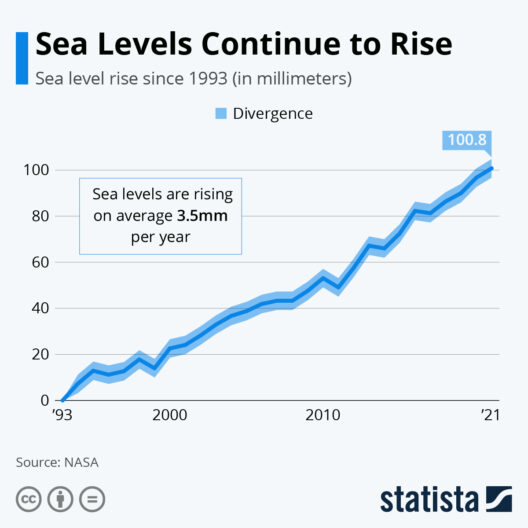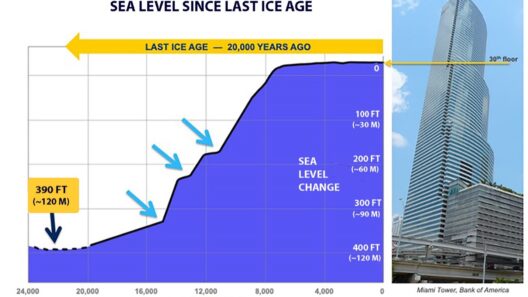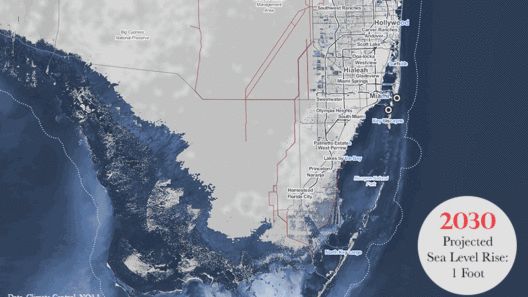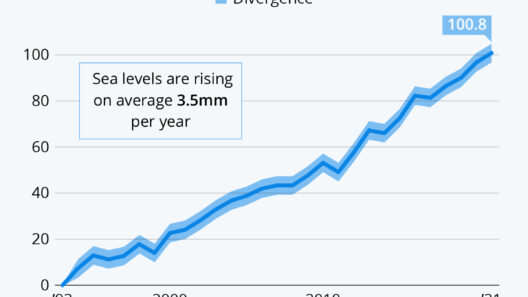Rising sea levels, predominantly a consequence of climate change, are poised to alter marine ecosystems in unprecedented ways. This phenomenon, driven by the thermal expansion of seawater and the melting of glaciers and polar ice caps, warrants a closer examination of its far-reaching implications for marine life. Understanding how these changes affect the intricate web of marine ecosystems is essential for both preservation efforts and the formulation of effective environmental policies.
The Magnitude of the Threat
The ocean, serving as Earth’s largest carbon sink, plays a pivotal role in regulating climate and sustaining biodiversity. As sea levels continue to rise globally, the fallout is profound. Coastal habitats, like mangroves, salt marshes, and coral reefs, are frequently inundated, leading to habitat loss for countless marine organisms. Furthermore, the encroachment of saltwater into freshwater systems disrupts the delicate balance required for species sensitive to salinity changes. This disruption threatens the survival of numerous fish species, shellfish, and other fauna that rely on specific environmental conditions.
In addition, coral reefs, often termed the “rainforests of the sea,” are particularly vulnerable. These biodiverse ecosystems depend on a symbiotic relationship between corals and zooxanthellae, photosynthetic algae residing within coral tissues. When warmer water temperatures and increased sedimentation from land runoff occur due to rising sea levels, the health of coral reefs deteriorates, leading to widespread bleaching events. These phenomena have cascading effects throughout the marine food web, ultimately impacting species that depend on corals for habitat and sustenance.
The Ripple Effect on Biodiversity
As marine ecosystems undergo transformation due to rising sea levels, biodiversity faces unprecedented challenges. Species competition intensifies as habitats migrate or diminish, compelling marine organisms to adapt or perish. For instance, some fish species may find their habitats reduced, forcing them to relocate. However, not all species can migrate efficiently. Those with limited mobility or specialized habitat requirements may face extinction, erasing centuries of evolution and unique biodiversity.
Moreover, the introduction of invasive species may exacerbate the problems faced by native marine organisms. With shifting habitats, invasive species often find new opportunities to thrive, outcompeting local species for essential resources. This has far-reaching consequences, not only for individual populations but also for the entire structure of marine ecosystems, affecting predator-prey relationships and nutrient cycling.
The Influence on Fisheries and Human Livelihoods
The repercussions of rising sea levels extend beyond natural ecosystems, directly influencing human activities and livelihoods, particularly fisheries. Coastal communities around the world depend on sustainable fisheries for economic stability and nourishment. As sea levels climb and ecosystems falter, fish populations may dwindle. Overfishing, coupled with habitat loss, leads to diminishing catches and threatens food security for millions.
Fishermen may also encounter significant challenges as traditional fishing areas become submerged or altered. The migration patterns of commercially important species can change, forcing local fishers to travel farther from shore in search of viable catches. This not only displaces communities but can also lead to further overexploitation as fishing fleets expand their reach into previously untouched territories.
To mitigate adverse effects, the fishing industry must innovate and adapt to these changing conditions. Implementing sustainable fishing practices, preserving key habitats, and investing in aquaculture could be valuable strategies for future resilience.
Habitat Restoration as a Solution
Addressing the impacts of rising sea levels on marine life requires a multifaceted approach. Habitat restoration plays a crucial role in enhancing the resilience of affected ecosystems. Initiatives aimed at restoring coastal wetlands, for instance, can provide critical buffering against storm surges and erosion while also serving as essential nurseries for various marine species.
Additionally, the protection of coral reefs through marine protected areas allows for recovery, giving these vital ecosystems a fighting chance against threats such as bleaching and overfishing. Implementing restoration processes focused on ecological restoration, including planting native vegetation and restoring natural water flow to coastal areas, can enhance the habitat’s ability to adapt and thrive amidst rising seas.
Celebrating Ocean Conservation
Education and community involvement are pivotal in fostering ocean conservation and resilience against the impacts of rising sea levels. Engaging local communities in stewardship initiatives nurtures a shared sense of responsibility for safeguarding marine ecosystems. People can contribute by participating in beach clean-ups, attending educational seminars, and supporting policies aimed at combating climate change. Every effort counts, yielding collective strength in the quest to protect our oceans.
Ultimately, the interplay between rising sea levels and marine life represents a complex tapestry that necessitates thorough investigation and action. As we unravel the depths of this issue, a clearer understanding emerges—one that emphasizes interconnectedness, highlights the fragility of ecosystems, and underscores the urgency for collective efforts. Our oceans, teeming with life and beauty, require our unwavering commitment to preserve them for future generations.
